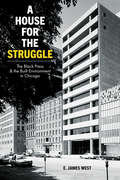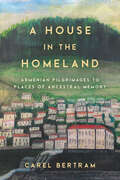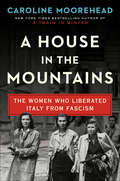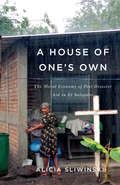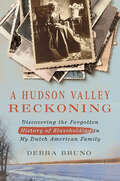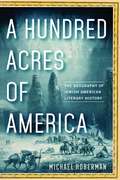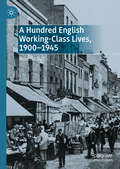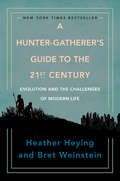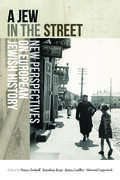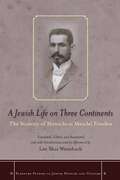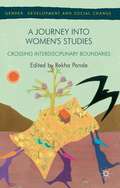- Table View
- List View
A House for the Struggle: The Black Press and the Built Environment in Chicago
by E. James WestBuildings once symbolized Chicago's place as the business capital of Black America and a thriving hub for Black media. In this groundbreaking work, E. James West examines the city's Black press through its relationship with the built environment. As a house for the struggle, the buildings of publications like Ebony and the Chicago Defender embodied narratives of racial uplift and community resistance. As political hubs, gallery spaces, and public squares, they served as key sites in the ongoing Black quest for self-respect, independence, and civic identity. At the same time, factors ranging from discriminatory business practices to editorial and corporate ideology prescribed their location, use, and appearance, positioning Black press buildings as sites of both Black possibility and racial constraint. Engaging and innovative, A House for the Struggle reconsiders the Black press's place at the crossroads where aspiration collided with life in one of America's most segregated cities.
A House in the Homeland: Armenian Pilgrimages to Places of Ancestral Memory (Worlding the Middle East)
by Carel BertramA powerful examination of soulful journeys made to recover memory and recuperate stolen pasts in the face of unspeakable histories. Survivors of the Armenian Genocide of 1915 took refuge across the globe. Traumatized by unspeakable brutalities, the idea of returning to their homeland was unthinkable. But decades later, some children and grandchildren felt compelled to travel back, having heard stories of family wholeness in beloved homes and of cherished ancestral towns and villages once in Ottoman Armenia, today in the Republic of Turkey. Hoping to satisfy spiritual yearnings, this new generation called themselves pilgrims—and their journeys, pilgrimages. Carel Bertram joined scores of these pilgrims on over a dozen pilgrimages, and amassed accounts from hundreds more who made these journeys. In telling their stories, A House in the Homeland documents how pilgrims encountered the ancestral house, village, or town as both real and metaphorical centerpieces of family history. Bertram recounts the moving, restorative connections pilgrims made, and illuminates how the ancestral house, as a spiritual place, offers an opening to a wellspring of humanity in sites that might otherwise be defined solely by tragic loss. As an exploration of the powerful links between memory and place, house and homeland, rupture and continuity, these Armenian stories reflect the resilience of diaspora in the face of the savage reaches of trauma, separation, and exile in ways that each of us, whatever our history, can recognize.
A House in the Mountains: The Women Who Liberated Italy from Fascism (The Resistance Quartet #4)
by Caroline MooreheadThe acclaimed author of A Train in Winter returns with the final volume in her Resistance Quartet—the powerful and inspiring true story of the women of the partisan resistance who fought against Italy’s fascist regime during World War II.In the late summer of 1943, when Italy broke with the Germans and joined the Allies after suffering catastrophic military losses, an Italian Resistance was born. Four young Piedmontese women—Ada, Frida, Silvia and Bianca—living secretly in the mountains surrounding Turin, risked their lives to overthrow Italy’s authoritarian government. They were among the thousands of Italians who joined the Partisan effort to help the Allies liberate their country from the German invaders and their Fascist collaborators. What made this partisan war all the more extraordinary was the number of women—like this brave quartet—who swelled its ranks.The bloody civil war that ensued pitted neighbor against neighbor, and revealed the best and worst in Italian society. The courage shown by the partisans was exemplary, and eventually bound them together into a coherent fighting force. But the death rattle of Mussolini’s two decades of Fascist rule—with its corruption, greed, and anti-Semitism—was unrelentingly violent and brutal. Drawing on a rich cache of previously untranslated sources, prize-winning historian Caroline Moorehead illuminates the experiences of Ada, Frida, Silvia, and Bianca to tell the little-known story of the women of the Italian partisan movement fighting for freedom against fascism in all its forms, while Europe collapsed in smoldering ruins around them.A House in the Mountains features black-and-white photographs throughout.
A House of One's Own: The Moral Economy of Post-Disaster Aid in El Salvador
by Alicia SliwinskiWhat happens to people after an earthquake destroys their homes? What is daily life like under a humanitarian regime? Is aid a gift or is it a form of power? A House of One’s Own explores these enduring questions as they unfold in a Salvadoran town in the aftermath of the 2001 earthquakes. In a lively, intimate account of the social complexities that arise in post-disaster settings, Alicia Sliwinski recounts the trajectories of fifty families who received different forms of humanitarian aid, from emergency assistance to housing reconstruction. Drawing on seminal anthropological theories about gift giving and moral economy, the author thoughtfully discusses the complications and challenges of humanitarian action that aims to rebuild communities through participation. At the crossroads of disaster studies and the anthropology of humanitarianism, the book’s insights speak to timely and recurring issues that relocated populations face in regimented and morally charged resettlement initiatives. A richly textured, analytically nuanced ethnography, A House of One’s Own is a perceptive firsthand account of what happens on the ground in a post-disaster setting.
A House of Prayer for All People: Contesting Citizenship in a Queer Church
by David K. SeitzPerhaps an unlikely subject for an ethnographic case study, the Metropolitan Community Church of Toronto in Canada is a large predominantly LGBT church with a robust, and at times fraught, history of advocacy. While the church is often riddled with fault lines and contradictions, its queer and faith-based emphasis on shared vulnerability leads it to engage in radical solidarity with asylum-seekers, pointing to the work of affect in radical, coalition politics. A House of Prayer for All People maps the affective dimensions of the politics of citizenship at this church. For nearly three years, David K. Seitz regularly attended services at MCCT. He paid special attention to how community and citizenship are formed in a primarily queer Christian organization, focusing on four contemporary struggles: debates on race and gender in religious leadership, activism around police–minority relations, outreach to LGBT Christians transnationally, and advocacy for asylum seekers. Engaging in debates in cultural geography, queer of color critique, psychoanalysis, and affect theory, A House of Prayer for All People stages innovative, reparative encounters with citizenship and religion. Building on queer theory&’s rich history of &“subjectless&” critique, Seitz calls for an &“improper&” queer citizenship—one that refuses liberal identity politics or national territory as the ethical horizon for sympathy, solidarity, rights, redistribution, or intimacy. Improper queer citizenship, he suggests, depends not only on &“good politics&” but also on people&’s capacity for empathy, integration, and repair.
A Hudson Valley Reckoning: Discovering the Forgotten History of Slaveholding in My Dutch American Family
by Debra BrunoA Hudson Valley Reckoning tells the long-ignored story of slavery's history in upstate New York through Debra Bruno's absorbing chronicle that uncovers her Dutch ancestors' slave-holding past and leads to a deep connection with the descendants of the enslaved people her family owned. Bruno, who grew up in New York's Hudson Valley knowing little about her Dutch heritage, was shaken when a historian told her that her Dutch ancestors were almost certainly slaveholders. Driven by this knowledge, Bruno began to unearth her family's past. In the last will and testament of her ancestor, she found the first evidence: human beings bequeathed to his family along with animals and furniture. The more she expanded her family tree, the more enslavers she found. She reached out to Black Americans tracing their own ancestry, and by serendipitous luck became friends with Eleanor C. Mire, a descendent of a woman enslaved by Bruno's Dutch ancestors.A Hudson Valley Reckoning recounts Bruno's journey into the nearly forgotten history of Northern slavery and of the thousands of enslaved people brought in chains to Manhattan and the Hudson Valley. With the help of Mire, who provides a moving epilogue, Debra Bruno tells the story of white and Black lives impacted by the stain of slavery and its long legacy of racism, as she investigates the erasure of the uncomfortable truths about our family and national histories.
A Human Being Died That Night: A South African Story of Forgiveness
by Pumla Gobodo-MadikizelaA Human Being Died That Night recounts an extraordinary dialogue. Pumla Gobodo-Madikizela, a psychologist who grew up in a black South African township, reflects on her interviews with Eugene de Kock, the commanding officer of state-sanctioned death squads under apartheid. Gobodo-Madikizela met with de Kock in Pretoria's maximum-security prison, where he is serving a 212-year sentence for crimes against humanity. In profoundly arresting scenes, Gobodo-Madikizela conveys her struggle with contradictory internal impulses to hold him accountable and to forgive. Ultimately, as she allows us to witness de Kock's extraordinary awakening of conscience, she illuminates the ways in which the encounter compelled her to redefine the value of remorse and the limits of forgiveness.
A Human Values Pathway for Teachers: Developing Silent Sitting and Mindful Practices in Education
by Suma Parahakaran Stephen SchererThis book combines perspectives from psychology, spiritual education and digital teaching pedagogies in a transnational framework to discuss the Education in Human Values Program (EHV) for child development, with a focus on silent sitting, mindfulness, meditation and story-telling as tools in the classroom. Through positive guidance in the early stages of child development using EHV tools, teachers will be better equipped to handle disciplinary issues in primary and secondary schools. These practices are also useful for the higher education community, as teachers and educators from tertiary institutions may adopt these practices in their teaching and become reflective practitioners. Topics such as teacher morale and school climate and its impact on children are discussed in relation to building resilience, reflective capacities, and inner strength (shared values) using an intrinsic and transformational approach. The discussions also include perspectives from the neurosciences. With contributions from teachers and educators from the US, South Africa, Malaysia, Australia, Hong Kong and Mauritius, this edited volume addresses the challenges, strengths and weaknesses associated with daily teaching practices in primary and secondary schools and higher education institutions. The content is relevant to policymakers and researchers in child development studies, with a particular focus on the impact of silent sitting, mindful practices, and meditation on children’s self-regulation and resilience. The authors collectively espouse that silent sitting techniques can help a child to grow and discover their hidden potential, thus enhancing their social, emotional, spiritual and physical capacities.
A Hundred Acres of America: The Geography of Jewish American Literary History
by Michael HobermanJewish writers have long had a sense of place in the United States, and interpretations of American geography have appeared in Jewish American literature from the colonial era forward. But troublingly, scholarship on Jewish American literary history often limits itself to an immigrant model, situating the Jewish American literary canon firmly and inescapably among the immigrant authors and early environments of the early twentieth century. In A Hundred Acres of America, Michael Hoberman combines literary history and geography to restore Jewish American writers to their roles as critical members of the American literary landscape from the 1850s to the present, and to argue that Jewish history, American literary history, and the inhabitation of American geography are, and always have been, contiguous entities.
A Hundred English Working-Class Lives, 1900-1945
by Rebecca BallStanley Rice, born in London in 1905, began his autobiography by stating that his life was ‘an ordinary average life with all its ups and downs’. Stanley may have described his life as ordinary, and yet he lived through a period of rapid social change, including two world wars. Despite this, Stanley assumed that his life story would be of little interest to most readers, as he had not achieved great fame or any notable accolades. This book argues that this is exactly why historians should focus on such life stories, as there is much to be gained by focusing on memories of ‘ordinary average lives’, as they can expand our knowledge of the past, often revealing firsthand experiences that have been excluded from the historical record. This book does not intend to be a general social history of the working class. Rather, it is a work of memory, drawing upon a microhistory methodology to examine how a sample of one hundred working-class autobiographers remembered and wrote about living through years that were punctuated by two worldwide conflicts and a global economic depression.
A Hundred Stories: Industrial Heritage Changes China
by Sunny Han Han Amal Zhuo LiThis book summarizes and classifies 100 wonderful Chinese industrial heritage cases, starting from the path of cultural tourism industry's involvement in the transformation and renewal of industrial heritage. With the development of industrialization for more than 100 years, China, which has been a major industrial heritage country, is often ignored in the field of industrial heritage research. This is the first book in the world to systematically explore the cultural and tourism industry's involvement in the transformation and renewal of Chinese industrial heritage. It fully contributed the wisdom and experience of the transformation of China's industrial heritage to the world, and provided important experience for the transformation of industrial heritage in other parts of the world. This book is not only a reference book for scholars, planners, and decision makers, but it will also inspire other readers who are concerned about China's urbanization and industrial heritage.
A Hunter-Gatherer's Guide to the 21st Century: Evolution and the Challenges of Modern Life
by Heather Heying Bret WeinsteinA bold, provocative history of our species finds the roots of civilization’s success and failure in our evolutionary biology. <P><P>We are living through the most prosperous age in all of human history, yet people are more listless, divided and miserable than ever. Wealth and comfort are unparalleled, and yet our political landscape grows ever more toxic, and rates of suicide, loneliness, and chronic illness continue to skyrocket. How do we explain the gap between these two truths? What's more, what can we do to close it? <P><P>For evolutionary biologists Heather Heying and Bret Weinstein, the cause of our woes is clear: the modern world is out of sync with our ancient brains and bodies. We evolved to live in clans, but today most people don't even know their neighbors&’ names. Traditional gender roles once served a necessary evolutionary purpose, but today we dismiss them as regressive. The cognitive dissonance spawned by trying to live in a society we're not built for is killing us. <P><P>In this book, Heying and Weinstein cut through the politically fraught discourse surrounding issues like sex, gender, diet, parenting, sleep, education, and more to outline a provocative, science-based worldview that will empower you to live a better, wiser life. They distill more than 20 years of research and first-hand accounts from the most biodiverse ecosystems on Earth into straight forward principles and guidance for confronting our culture of hyper-novelty. <P><P><b>A New York Times Best Seller</b>
A Japanese Advertising Agency: An Anthropology of Media and Markets (ConsumAsian Series #No. 3)
by Brian MoeranThis is the only book of its kind - written by an anthropologist who spent twelve months doing fieldwork in a major Tokyo agency and who has spent the past 30 years studying and living in Japan.By examining the production of advertising, this book turns other semiotics, media and cultural studies theories on their heads. By analysing the social structure of a modern media organization from the inside, it makes anthropology relevant and intellectually stimulating. By treating the Japanese as a more-or-less normal and rational people, it explodes the usual myths of exotic Japan and steps boldly into a global arena that embraces 'east' and 'west' in a new theory of values.
A Japanese Joint Venture in the Pacific: Foreign bodies in tinned tuna (Routledge Contemporary Japan Ser.)
by Kate BarclayThe Japanese, and other Asians, are increasingly taking over some of the roles previously played by Europeans in the Pacific islands, which is giving rise to interesting new economic relationships, and interesting new interactions between nationalities. This book considers the role of the Japanese in the Solomon Islands, focusing in particular on a
A Japanese View of Nature: The World of Living Things by Kinji Imanishi (Japan Anthropology Workshop Series)
by Kinji ImanishiAlthough Seibutsu no Sekai (The World of Living Things), the seminal 1941 work of Kinji Imanishi, had an enormous impact in Japan, both on scholars and on the general public, very little is known about it in the English-speaking world. This book makes the complete text available in English for the first time and provides an extensive introduction and notes to set the work in context. Imanishi's work, based on a very wide knowledge of science and the natural world, puts forward a distinctive view of nature and how it should be studied. Imanishi's work is particularly important as a background to ecology, primatology and human social evolution theory in Japan. Imanishi's views on these subjects are extremely interesting because he formulated an approach to viewing nature which challenged the usual international ideas of the time, and which foreshadow approaches that have currency today.
A Jew in the Roman Bathhouse: Cultural Interaction in the Ancient Mediterranean
by Yaron EliavA provocative account of Jewish encounters with the public baths of ancient RomePublic bathhouses embodied the Roman way of life, from food and fashion to sculpture and sports. The most popular institution of the ancient Mediterranean world, the baths drew people of all backgrounds. They were places suffused with nudity, sex, and magic. A Jew in the Roman Bathhouse reveals how Jews navigated this space with ease and confidence, engaging with Roman bath culture rather than avoiding it.In this landmark interdisciplinary work of cultural history, Yaron Eliav uses the Roman bathhouse as a social laboratory to reexamine how Jews interacted with Graeco-Roman culture. He reconstructs their thoughts, feelings, and beliefs about the baths and the activities that took place there, documenting their pleasures as well as their anxieties and concerns. Archaeologists have excavated hundreds of bathhouse facilities across the Mediterranean. Graeco-Roman writers mention the bathhouse frequently, and rabbinic literature contains hundreds of references to the baths. Eliav draws on the archaeological and literary record to offer fresh perspectives on the Jews of antiquity, developing a new model for the ways smaller and often weaker groups interact with large, dominant cultures.A compelling and richly evocative work of scholarship, A Jew in the Roman Bathhouse challenges us to rethink the relationship between Judaism and Graeco-Roman society, shedding new light on how cross-cultural engagement shaped Western civilization.
A Jew in the Street: New Perspectives on European Jewish History
by Michael Brenner Daniel Schwartz Elisheva Carlebach Israel Bartal Kalman Weiser David Assaf Magda Teter Michael L. Miller Natan M. Meir Edward Fram Gershon Hundert Jonathan Gribetz Olga Litvak Nils Roemer Gil Rubin Rebekah Klein-PejšováThis collection brings together original scholarship by seventeen historians drawing on the pioneering research of their teacher and colleague, Michael Stanislawski. These essays explore a mosaic of topics in the history of modern European Jewry from early modern times to the present, including the role of Jewish participants in the European revolutions of 1848, the dynamics of Zionist and non-Zionist views in the early twentieth century, the origins of a magical charm against the evil eye, and more. Collectively, these works reject ideological and doctrinal clichés, demythologize the European Jewish past, and demonstrate that early modern and modern Jews responded creatively to modern forms of culture, religion, and the state from the eighteenth to the twentieth century. Contributors to this volume pose new questions about the relationship between the particular and universal, antisemitism and modernization, religious and secular life, and the bonds and competition between cultures and languages, especially Yiddish, Hebrew, and modern European languages. These investigations illuminate the entangled experiences of Jews who sought to balance the pull of communal, religious, and linguistic traditions with the demands and allure of full participation in European life.
A Jewish Archive from Old Cairo: The History of Cambridge University's Genizah Collection (Culture and Civilization in the Middle East)
by Stefan ReifExplains how Cairo came to have its important Genizah archive, how Cambridge developed its interests in Hebraica, and how a number of colourful figures brought about the connection between the two centres. Also shows the importance of the Genizah material for Jewish cultural history.
A Jewish Childhood in the Muslim Mediterranean: A Collection of Stories Curated by Leïla Sebbar (University of California Series in Jewish History and Cultures #2)
by Lia BrozgalA free ebook version of this title is available through Luminos, University of California Press’s Open Access publishing program. Visit www.luminosoa.org to learn more.A Jewish Childhood in the Muslim Mediterranean brings together the fascinating personal stories of Jewish writers, scholars, and intellectuals who came of age in lands where Islam was the dominant religion and everyday life was infused with the politics of the French imperial project. Prompted by novelist Leïla Sebbar to reflect on their childhoods, these writers offer literary portraits that gesture to a universal condition while also shedding light on the exceptional nature of certain experiences. The childhoods captured here are undeniably Jewish, but they are also Moroccan, Algerian, Tunisian, Egyptian, Lebanese, and Turkish; each essay thus testifies to the multicultural, multilingual, and multi-faith community into which its author was born. The present translation makes this unique collection available to an English-speaking public for the first time. The original version, published in French in 2012, was awarded the Prix Haïm Zafrani, a prize given by the Elie Wiesel Institute of Jewish Studies to a literary project that valorizes Jewish civilization in the Muslim world.
A Jewish Life on Three Continents: The Memoir of Menachem Mendel Frieden
by Lee Shai WeissbachThis remarkable memoir by Menachem Mendel Frieden illuminates Jewish experience in all three of the most significant centers of Jewish life during the late nineteenth and early twentieth centuries. It chronicles Frieden's early years in Eastern Europe, his subsequent migration to the United States, and, finally, his settlement in Palestine in 1921. The memoir appears here translated from its original Hebrew, edited and annotated by Frieden's grandson, the historian Lee Shai Weissbach. Frieden's story provides a window onto Jewish life in an era that saw the encroachment of modern ideas into a traditional society, great streams of migration, and the project of Jewish nation building in Palestine. The memoir follows Frieden's student life in the yeshivas of Eastern Europe, the practices of peddlers in the American South, and the complexities of British policy in Palestine between the two World Wars. This first-hand account calls attention to some often ignored aspects of the modern Jewish experience and provides invaluable insight into the history of the time.
A Journey Called Aging: Challenges and Opportunities in Older Adulthood
by James C. Fisher Henry C. SimmonsA Journey Called Aging presents an insightful exploration of the years between the entry into older adulthood and death. This text examines the significant changes and major landmarks of older persons between 60 and 90. Grounded by a developmental framework based on empirical research, this book presents a new way of looking at older adulthood, describing the older adult years in intensely human terms through both anecdotes and research-based findings to engage the reader as both guide and traveler. Using a series of sequential stages as a framework, A Journey Called Aging discusses the experiences of older adults addressing the challenges and opportunities presented at each stage. This clear analysis can be used as a guide to help persons plan their own odyssey through the older years. Topics in A Journey Called Aging include: research and results of the study entering older adulthood the long stable stage of Extended Middle Age Early Transition Older Adult Lifestyle Later Transition the stable stage near the end of life the final transition A Journey Called Aging is crucial reading for professionals who work with older adults, including pastors, attorneys, facilities managers, and program directors; gerontology educators and students; and older adults themselves, their families, and those who care for and about them.
A Journey Through Qualitative Research: From Design to Reporting
by Stéphanie Gaudet Dominique RobertThis hands-on guide takes students from start-to-finish through the research process while showcasing the complexities and interrelationships of different methods, schools of thought, and associated analytical strategies. Encouraging students to think of qualitative research as a flexible, cyclical process rather than a linear one, this book offers a panoramic strategy and dynamic approach to qualitative research that accommodates the fluid nature of research and accounts for lessons learned through lived experience. With an emphasis on the analysis stage—within case, across case, and the dialogue between these insights and existing literature—it uses concrete applications to show how your methodological decisions translate into practice. It covers: Forming, defending, and evaluating research questions Choosing a research approach Ensuring ethically sound research Collecting quality data Analyzing data in layers Reporting research results Through a conversational tone that unpacks key vocabulary and acts as a companion supervisor, this book equips you to traverse every step of the qualitative research journey.
A Journey Through Qualitative Research: From Design to Reporting
by Stéphanie Gaudet Dominique RobertThis hands-on guide takes students from start-to-finish through the research process while showcasing the complexities and interrelationships of different methods, schools of thought, and associated analytical strategies. Encouraging students to think of qualitative research as a flexible, cyclical process rather than a linear one, this book offers a panoramic strategy and dynamic approach to qualitative research that accommodates the fluid nature of research and accounts for lessons learned through lived experience. With an emphasis on the analysis stage—within case, across case, and the dialogue between these insights and existing literature—it uses concrete applications to show how your methodological decisions translate into practice. It covers: Forming, defending, and evaluating research questions Choosing a research approach Ensuring ethically sound research Collecting quality data Analyzing data in layers Reporting research results Through a conversational tone that unpacks key vocabulary and acts as a companion supervisor, this book equips you to traverse every step of the qualitative research journey.
A Journey into Women�s Studies
by Rekha PandeUnlike many other mainstream disciplines that only seek to broaden knowledge and thus become additive, women's studies try to question and posit new ways of thinking, inaugurating paradigm shifts and thus becoming subversive by trying to question established hierarchies of knowledge. This has not been an easy journey and the practitioners of this new approach have faced numerous odds as all pioneering endeavours encounter. This journey is a story that needs to be told and the present book attempts to do this by charting the trajectories of few women's studies scholars and their academic sojourn. These scholars have been confined not just to the traditional dominant hierarchies of knowledge but by their own making, ventured into new areas, which has now emerged from the margins to the forefront. The point of emphasis is that the writings of scholars like Cynthia Enloe who dared to break boundaries and were questioned earlier have now become part of an acclaimed field of research. This volume explores the metamorphosis of women's studies from the early days to date and draws upon the contributors' diverse experiences and concerns, but all revolving around the same key issue: gender.
